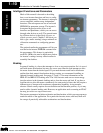
Introduction to Variable-Frequency Drives
Getting Started
1–8
An inverter, in general, is a device that converts DC power to AC power. The popular
consumer power inverter is designed for powering an AC appliance from a car battery;
put 12VDC in, and get 115VAC 50/60 Hz out, for example. The figure below shows how
the variable-frequency drive employes an internal inverter. The drive first converts
incoming AC power to DC through a rectifier circuit, creating a high-voltage internal DC
bus. Then the inverter circuit inverts the DC back to AC again to power the motor.
However, this special inverter varies its output frequency and voltage according to the
desired motor speed.
The simplified drawing of the inverter shows three double-throw switches. Usually
implemented with six power transistors, outputs U/T1, V/T2, and W/T3 may switch
positively or negatively. Using a commutation algorithm, the microprocessor in the drive
switches the power transistors on and off at a very high speed to create the desired output
waveforms. The reactance of the motor windings helps smooth out the pulses.
Torque and Constant Volts/Hertz Operation
In working with industrial motors we often discuss the motor torque. That is simply the
rotational force the motor exerts at any given time. The goal of the inverter is to control
motor speed, but the L100 inverter only has direct control over the output frequency and
voltage. The no-load speed will be equal to the inverter output frequency minus a small
amount of slip in the motor (slip is the difference between theoretical motor speed and
actual speed). As the load increases, the slip and the delivered torque also increase . If
the inverter can create strong motor torque over most or all of the speed range, then it is
relatively easy for the system to achieve any desired speed. Speed regulation is a
measure of the accuracy speed control, given as a percent difference from a fixed value.
The L100 delivers speed regulation (no load to full load) within 3% of the (full scale)
motor nameplate speed value.
When varying the output frequency, the inverter
drive also must vary the output voltage in propor-
tion to the frequency. It does so because of the
motor’s characteristic inductive reactance. If the
drive maintains a constant volts-per-hertz ratio, the
motor will have constant torque characteristics.
Constant torque is desirable for most applications,
because it transfers power to the load consistently
across the entire speed range.
Power
Input
Inverter
L1
Motor
L2
L3
Rectifier
Variable-frequency Drive
High-voltage
DC Bus
+
+
–
U/T1
V/T2
W/T3
Converter
100%
0
V
Output frequency
f
Constant torque
Output
voltage
100%
Technologies Inc.
Toll Free: voice: 1-877-539-2542 fax: 1-800-539-2542 www.mgitech.com


















